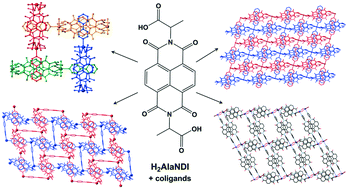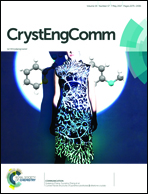A robust metallomacrocyclic motif for the formation interpenetrated coordination polymers†
Abstract
The reproducibility of an M2L2 metallomacrocyclic synthon containing L-alanine substituted naphthalene diimide ligands (AlaNDI), and its ability to form both catenane and rotaxane motifs, has been demonstrated in a series of nine homochiral coordination polymers. The planes of the NDIs that comprise the metallomacrocycle are ∼7 Å apart, an ideal distance for an aromatic group to reside within the ring with multiple parallel π-interactions. The tendency for these systems to be dominated by π-interactions appears to be a driving force for interpenetration of these coordination polymers by either the formation of catenanes between two {M2(AlaNDI)2} metallomacrocycles or the formation of rotaxanes by dipyridyl coligands passing through metallomacrocycles (4,4′-bipyridine, dipyridylethene and dipyridylnaphthalenediimide). Due to both of these interpenetration motifs being facilitated by parallel π-interactions, the interpenetration of the individual networks does not typically lead to increased dimensionality in the structures, with the exception of one material in which a 1D chain interpenetrates in a 1D → 2D manner. Two of the reported coordination polymers, both containing dipyridylnaphthalenediimide (4PyNDI), are not interpenetrated with π-interactions present between the 4PyNDI ligands themselves rather than engaging with the macrocycles. Overall the reproducibility of the metallomacrocycle, and the relatively common occurrence of catenane and rotaxane motifs, suggests that this is a promising synthon for further crystal engineering applications.



 Please wait while we load your content...
Please wait while we load your content...